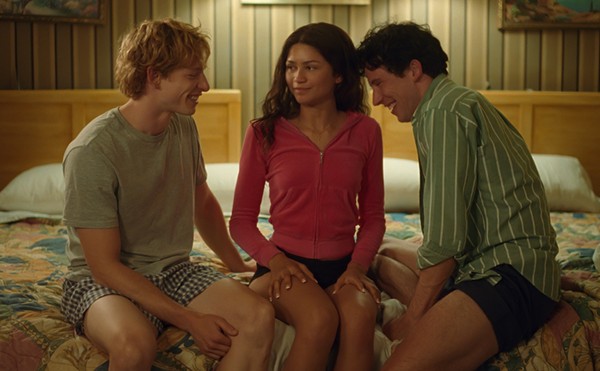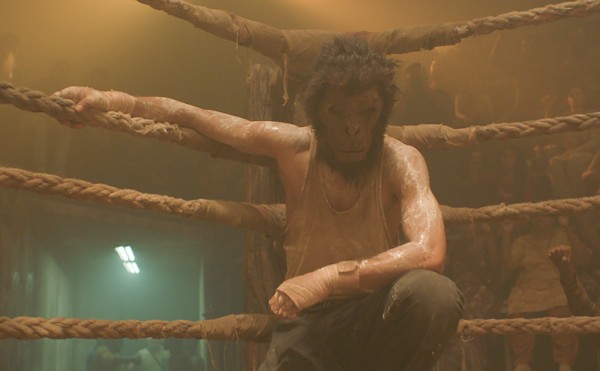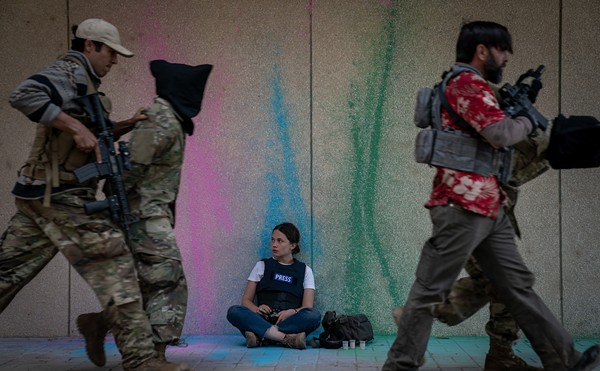Co-written and directed by George Miller
A brave movie for a brave pig, the second of Babe's excellent adventures takes significant risks with the franchise -- not only placing the charming porker in a dizzying succession of tight spots, which we'd rightly expect, but also moving the narrative from the bucolic farmlands of the original to the sinister environs of the Ur-city, a fantastic megalopolis that incorporates the significant landmarks of the world's major capitals and fulfills the nightmarish urban expectations of even the most paranoid ruralist. The dark turn Babe: Pig in the City takes is entirely in keeping with the direction of the first film -- Mrs. Hoggett (Magda Szubanski), after all, regularly butchered the livestock, threatening Babe himself and earning her the sobriquet "serial murderer" from Ferdinand the duck -- but co-writer/director George Miller drives the movie forward with the same relentless fury of his hyperkinetic Road Warrior, and the pathetic souls and predatory creeps whom Babe encounters on his journey have a cuttingly realistic edge.
The story essentially begins with Farmer Hoggett (James Cromwell) taking a terrifying, Wile E. Coyote-esque header into a well, an accident precipitated by the helpful but hapless Babe; his incapacity in turn plunges the farm into debt, and potential forfeiture looms. Grim from the getaway, Babe: Pig in the City only grows more harrowing when Mrs. Hoggett accepts a lucrative, farm-saving offer and takes Babe the sheep-pig to a fair for a demonstration of his vaunted herding prowess. Salvation is not so easily attained, however: Detained as a potential drug smuggler -- and subjected to a full body-cavity search! -- Mrs. Hoggett misses her connecting flight and finds herself stranded in the distinctly unwelcoming city. Although they find temporary sanctuary in a animal-friendly hotel, she and Babe are soon separated, with both facing a daunting array of obstacles to hurdle before their hoped-for reunion and return to the countryside.
In addition to its headlong pace and scarifying plot, Babe: Pig in the City moves further into unmapped territory by introducing new characters rather than simply revisiting old friends: Farmer Hoggett, Fly and Rex are reduced to little more than cameos, and even sidekick Ferdinand is forced to the film's margins. But the movie scarcely misses them, vastly expanding Mrs. Hoggett's role -- with Szubanski gamely enduring a gauntlet of cartoonish misfortune -- and providing opportunity to more than a half-dozen fresh cast members, including the hotel's zoophilic landlady (Mary Stein), a quartet of primates (chimp couple Bob and Zootie, mischievous Capuchin monkey Easy and grandly reserved orangutan Thelonious), an ill-used poodle, an undaunted paraplegic dog and an insistently protective English bull terrier. The chimpanzees, although winningly voiced by Glenne Headly and Steven Wright, receive a disproportionate share of screen time -- and their clown owner, Fugly Floom (a mugging, desperately unfunny Mickey Rooney), cannot be dispatched too quickly -- but most of the new critters prove satisfying additions. Nor are old-timers entirely slighted: The mouse Greek chorus makes a welcome return, inimitably warbling Edith Piaf and Elvis; Roscoe Lee Browne narrates with his usual warmth; and Babe, though now voiced by E.G. Daily, is his plucky, irresistibly lovable self.
Kids with a low terror threshold might find Babe: Pig in the City a heart-accelerating fright, but the real-world issues that produce the worst of those anxieties make the film a must-see for both adults and children. Miller and co-writers Judy Morris and Mark Lamprell slyly insert references to a wide spectrum of animal-rights concerns -- exposing society's benighted attitude toward pets as casually disposable objects, implicitly endorsing vegetarianism, condemning animal experimentation -- but whether you embrace or reject those views, Babe: Pig in the City teaches valuable lessons in compassion and cooperation (both inter- and intraspecies) that unfortunately require constant reinforcement. And when a film educates with such wildly entertaining brio, even the most stone-hearted and cynical among us are compelled to admit, "That'll do, pig. That'll do."
-- Cliff Froehlich
SLAM
Co-written and directed by Marc Levin
For years, media has had a field day exploiting and sensationalizing the "tough hood/drugs/violence/prison" trajectory, providing inconsequential insights while soft-pedaling social responsibility. Moreover, rarely do any narratives champion the liberating emotional release or the intellectual thrill that artistic creativity offers, especially in a bleak sociopolitical environment -- until Slam. Celebrating talent and holding out hope, director/co-writer/producer Marc Levin rejects ghetto cliches in favor of individuals who must find the courage to confront their own responsibilities and opportunities within a violent milieu. It can be as frightening to put your ego on the line as your life. Until now, we haven't seen or felt or heard a young black man's story told in quite this fashion.
After the film establishes Ray Joshua's charged personality and depressed neighborhood, events thrust Ray into the middle of a shooting in the tough Washington, D.C., housing project appropriately called Dodge City. The police arrest Ray for possession of 4 ounces of marijuana, thereby plunging him into the dispiriting morass of the capital's judicial system. Through a volatile relationship with writing teacher/love interest Lauren Bell, Ray finds his rap-poetry a refuge for his mind and a protection for his body in some tense prison scenes as two gangs compete for Ray's allegiance and square off against each other.
Intensifying Slam's edgy tautness, experienced nonfiction director Levin shot on D.C.'s streets and in D.C.'s Central Detention facilities with real guards and prisoners who volunteered their time. Drawing on years of experience documenting the juvenile justice system, street gangs, prison life and the CIA, Levin captures spontaneous performances, often literally unrehearsed with nonprofessionals. For example, after Ray's initial processing, the jail rap exchange occurred, unscripted.
As Ray, Saul Williams brings the authenticity of an expert at "slamming," competing head-to-head in rap-poetry performances. Both Williams and Sonja Sohn, who plays Lauren, wrote their own great material. Ex-D.C. Mayor Marion Barry Jr. adds an ironic touch in his appearance as a tough criminal-courts judge.
Slam has a dynamic soundtrack and an accomplished cinema verite style, especially impressive given the film's $1 million budget and its two-and-a-half-week shooting schedule. Through some melodramatic twists and turns, some wild mood swings and a few ragged scene shifts, the plot couples raw kinetic action with poised performances. As tribute to its electrifying energy, Slam won audience awards not only at the recent St. Louis International Film Festival but also at Sundance and Cannes, where it also won as the best first feature.
With a refreshing abandon, Levin has us rooting for Ray and knowing he's worth more than he at first believes. We come to care deeply about and to understand the anguish of Ray Joshua and to see his immense promise. It is exactly this belief in himself that Ray must embrace and that draws us into his battle. Slam evokes honest sentiment in a story of struggle moving toward triumph.
Opens Dec. 11 at the Tivoli.
-- Diane Carson
VERY BAD THINGS
Written and directed by Peter Berg
Let's face it: Dismemberment is funny. Not pulling the wings off flies or chopping off lizards' tails to see whether they'll grow back -- that stuff's pathological. But humans losing limbs left and right? Well, you don't have to be a hard-core Freudian to find that downright hilarious. (That's what made Saving Private Ryan such a hoot, no?) And of course it's even better when those being divided up are already dead; news stories about people who murder their lovers and then pack the body parts off to different states can be just side-splitting.
At least that seems to be the premise inspiring Peter Berg, writer and director of Very Bad Things. Billed (for some reason) as "a very savage comedy," Very Bad Things tells the sorry tale of five buddies from LA who travel to Las Vegas for a wild bachelor party on the eve of the wedding of Kyle (Jon Favreau) and Laura (Cameron Diaz). In Vegas, the prostitute (Carla Scott) they've hired to strip for them is accidentally killed, and the panicky crew then murder the security guard (Russell B. McKenzie) who discovers the crime. Under the direction of Boyd (Christian Slater, also the film's executive producer) they conspire to continued on page 65continued from page 63cut up the bodies, smuggle them out of the hotel, bury them in the desert and keep the grisly secret. But guilt and paranoia and bad luck lead to an increasingly outrageous series of killings designed to keep that secret, as the wedding day -- the perfection of which is Laura's constant obsession -- comes ever closer.
We're invited to laugh as things spiral increasingly out of control, but the impulse is rarely irresistible. Partly that's a problem of perspective: A comedy, even a putatively black comedy, needs some consistent point of view from which its absurd and extravagant antics can be viewed, but Very Bad Things can't decide until the final 20 minutes whether it means to be Heathers for Grownups or I Know What You Did Last Week in Las Vegas or an exploration of the varieties of male hysteria. Granted, Slater's manic, fully self-actualized Boyd is consistently rendered (and consistent with his screen persona), but the film isn't really ever on his side -- at least not for more than a few minutes at a time. The other problem is one of tone, or perhaps measure: Diaz's character (yeah, I know, we're supposed to praise her every gesture nowadays) is offered up for our amusement because she's so preoccupied with the trivial details of the impending wedding -- she's shallow, you see, because she hasn't killed and mutilated anyone. Yet.
Very Bad Things is Berg's directorial debut. Before he makes another film, I think he should be made to answer the following questions, preferably in writing: Why does the prostitute that the five white guys dismember have to be Asian? Why does the hotel security guard have to be black? And why, once Laura joins in the mayhem at the very end, does she have to be the one who bears the final burden for the tragic mishap with which the story begins? Unlike Very Bad Things, the answers should not take 111 minutes to provide.
-- Frank Grady
SHATTERED IMAGE
Directed by Raul Ruiz
A dark-haired, smartly dressed woman sits at a smoky, neon-lit bar, watching defiantly as a table of men send her a drink. She follows one of the men into the restroom and coolly fires three bullets into his chest. From the stark lighting to the syrupy saxophone playing on the soundtrack, the opening sequence of Shattered Image is indistinguishable from any of the hundreds of "erotic thrillers" and La Femme Nikita knockoffs (in fact, the woman behind the gun is Nikita herself, Anne Parillaud) that can be found most nights on cable TV.
No sooner has Jessie, the assassin, returned to her apartment than the film introduces another Jessie (also played by Parillaud), a less exotic and more troubled heroine, waking up from a dream. A wealthy but naive woman on honeymoon in Jamaica, this Jessie is emotionally fragile, with a suicide attempt and a sexual assault in her past. Suspicious of everyone, even her new husband (William Baldwin), and convinced that her attacker is still stalking her, she's as helpless as her dream alter ego is self-confident. This second story, the threatened woman on the verge of a breakdown, is in its own way as familiar as that of the competent hitwoman.
From the banal threads of the glossy violent programmer and the romantic suspense melodrama, Shattered Image fashions a stylish and intelligent psychological thriller, one of the most clever reworkings of the suspense genre (with specific nods to Vertigo) since Brian De Palma's string of neo-Hitchcock studies of the early '80s. The first major English-language feature from the prolific Chilean-born but multinational Raul Ruiz (who has made nearly 100 films of varying length over the last four decades -- of which only about five have been screened locally), Shattered Image makes no attempt to disguise its mundane plot(s), recognizing both as fertile sources for cinematic dreamwork. Allowing neither story a privileged position, Ruiz and screenwriter Duane Poole allow the two narratives to intertwine and redirect each other: The heiress dreams of the ruthless killer, hoping that the latter's pursuit of a new victim will provide answers to her own problems, while the assassin Jessie dreams of her weaker counterpart and finds her carefully ordered world thrown out of step by elements from the other woman's history.
The film is deceptively simple at first, so much so that for the first 20 minutes, I found myself wondering how filmmakers as distinguished as Ruiz and producer Barbet Schroeder became involved in such a routine project. More a fabulist than a stylist (critics almost inevitably compare him to Borges), Ruiz is more interested in the process of storytelling than in the legitimization of a particular plot. Though the cinematography of Robby Muller is excellent, Ruiz likes his films simple, favoring analysis over imagery. By treating his two worlds, the dreamworld of the killer and the (apparently) real world of the honeymooners at face value, he allows a more complex fiction to unfold. Are the two Jessies twin halves of a shattered personality, or are they literally dreaming each other? In Ruiz's view, psychology takes a backseat to imagination, and just when it appears that the film has reached a tight, simple conclusion, a new puzzle opens.
In his last film, That Obscure Object of Desire, the late Luis Bunuel (whose surrealist sensibility is shared by Ruiz) used two actresses in a single role to show the conflicting sides of a single personality. Ruiz achieves something similar here: The performers, most of them in dual roles, shift between the two dreamworlds, only partly aware that they have a doppelganger on the other side. Parillaud is especially affecting, often bringing the conflicting sensibilities of the murderer and the victim together within a single scene. Like her performance, Shattered Image is a subtlecontinued on next pagecontinued from previous pagetriumph, familiar on the surface but gradually unfolding layers of complexity and insight.
Opens Dec. 4 at the Plaza Frontenac.
-- Robert Hunt
ACTION/PERFORMANCE AND THE MOVING CAMERA
Various Artists
Even in this age of impermanence, especially in this age of impermanence, those images that leave an impression, those narratives that remain, the material that remains memorable amid the ephemera -- this is where art carries its power. And because this is an age of impermanence, it is increasingly difficult for artists to gain the attention of more than the cursory glance. That glance diminishes art and would make philistines of us all.
These thoughts arose after I saw the group of videos to be presented at the Forum for Contemporary Art at 7 p.m. Wednesday, Dec. 2. Video artists are especially susceptible to an indifferent audience because of how video and film have become the art form for the mass audience, a form that has attained a visual language that works at a highly sophisticated level. Although most of the artists on display in this short series are not seeking that mass audience, they still must find a way to produce a unique visual document for an audience that has just about seen it all.
The artists in this series who succeed do so primarily by achieving a level of intimacy that is rare for the medium. Video, which is so cool, they make warm -- or even hot, as found in the smoldering anger within the work of Guillermo Gomez-Pena. For the most part these are personal documents, but ones that touch on broad themes encompassing politics, history and identity.
The most compelling of these -- those which extend beyond the glance and last in the memory -- are works by Gomez-Pena and Linda Montano. They're the most interesting to consider because of how they are effective in such contrary ways. As Gomez-Pena is full of flash, sensation, cross-cuts, noise, Montano is slow, methodical, repetitive, contemplative. Gomez-Pena would confront the viewer with a testament of North American racism; Montano would seek an artistic expression without purpose.
Gomez-Pena's "Borderstatis: The Many Lives of an End-of-the-Century Bandit" shows the performance artist wearing the many masks of stereotype that the dominant culture affixes on Latinos. He is the Aztec cosmic warrior, dressed as Montezuma with a ray gun; he is a Zapata-like bandito; he is the dangerous, dark, menacing inner-city gangbanger. Throughout "Borderstatis," Gomez-Pena's dry wit and lucid irony make for an entertaining mix, but the work is remarkably poignant as well. The anger of the piece gives way to melancholy: the realization that the situation of racism dooms us all to an ironic stance.
Montano's "Seven Years of Living Art" is perhaps the work most threatened by the cursory observation. Montano is known for marathon projects that dissolve boundaries between life and art: In one performance she was bound to another artist by a rope for one year. In "Seven Years," she follows the chakras of the body as defined by kundalini yoga, from the chakra at the base of the spine (signified by the color red and connected to one's sexuality) on up to the seventh chakra at the top of the head (signified by the color white and connected to spirituality). To each of the seven chakras Montano devotes a year of her life. She wears only red, for instance, during the first year devoted to the first chakra, sits in a red room a number of hours each day and, she remarks without further explanation, has a year that is abundantly sexual.
The literalness of Montano is often tiresome (must that which is so potent as metaphor be made so physically plain?), yet of the works shown in this series, hers is one I suspect will be most talked-about. As Montano dissolves the line between art and life, so too she erases the divide between acts that might be called courageous and those that might be thought absurd. Her narrative passes into our conversations, into our thoughts and dreams, our own impermanence rendered and given attention.
-- Eddie Silva
POVERTY OUTLAW
Directed by Pam Yates and Peter Kinroy
Dec. 10, 1998, marks the 50th anniversary of the United Nations Declaration of Human Rights. The Webster University Film Series celebrates with a screening of Poverty Outlaw, an unforgettable glimpse into poverty's human face.
The time is now. The place is Philadelphia's Kensington neighborhood: once bustling with factories, now in ruins. Some residents left to look for work elsewhere -- with who knows what result. Others stayed. Poverty Outlaw centers on those who stayed, especially the anonymous narrator. Her story gives this nonfiction film its shape. Its energy and momentum come from the welfare-rights union she helped organize. Its drama comes from the most basic struggle to survive.
Kensington could be anywhere in the world that has lost its economic base of mine, factory, slaughterhouse, steel mill or auto plant. Poverty Outlaw's narrator tells about growing up in Kensington before "the fall." Both her parents worked; together they provided a secure life for their children. When Kensington "fell," she found herself desperately poor. Her ex-husband vanished, leaving her to support two children on a minimum-wage job -- if she could find one.
Like many working-class people who had always worked, the narrator never expected to end up on welfare. With food stamps and Medicaid, the family was better off than with a no-insurance minimum-wage job, but they still could not live. Women who hadn't lost their looks could earn extra income as prostitutes. Others woke up not knowing how they would feed their children each day. Most somehow became "outlaws" to survive. One man devised a new hookup after the electric company cut his power. This film shows compellingly how poverty wastes and misdirects human potential -- to everyone's loss.
The narrator tells how she helped form the Kensington Welfare Rights Union. With poverty their link -- and raising children their common goal -- the poor ironed out their group differences and learned to work together. The story's pivot is a summer when they also lived together in a "tent city" with only a fire hydrant for water. Evicted for falling behind on the rent, they asked the city to let them move into abandoned buildings. They also wanted a long-vacant government building for a child-care center.
Poverty Outlaw's most distinctive feature is that a poor person tells her story and describes Kensington from her own viewpoint. The film also shows Kensington from her viewpoint. I was impressed with the energy, intelligence, love and commitment behind the union. I am haunted by the narrator's voice -- and most of all by all those faces. How different poverty looks in the abstract and in a single face.
After the screening, Chuck Collins, co-founder and co-director of United for a Fair Economy, and Art Sandler, director of Webster U.'s Human Rights Education Project, will speak. The event is free.
Plays at 7 p.m. Dec. 8 at Webster University.
-- Susan Waugh






